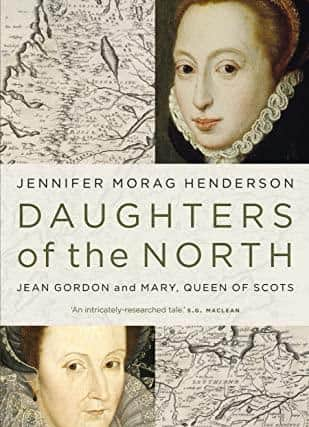Book review: Daughters of the North, by Jennifer Morag Henderson


Jean Gordon, daughter of the Earl of Huntly, known like subsequent holders of that title as “The Cock o’ the North”, played a small and little regarded or well remembered part in the drama of Mary, Queen of Scots. Herself a Catholic, she was briefly married to the Protestant Earl of Bothwell, who was generally held to be the man responsible for the murder of Mary’s second husband, Lord Darnley. She was divorced from Bothwell, with, it appears, his consent, on grounds of his adultery with one of her servants, and to make matters doubly sure, the marriage was annulled by the Roman Church. Bothwell then forced marriage on the Queen, an act which provoked rebellion. Mary was taken prisoner by the Protestant Lords of the Congregation, led by her half-brother, the Earl of Moray, compelled to abdicate while held in Loch Leven Castle, escaped, rallied supporters, before, having been defeated in the Battle of Langside, she sought refuge in England with, as we all know, lamentable consequences. Bothwell himself fled to the North, where he was titular Duke of Orkney, then to Denmark where he eventually died raving mad in prison.
The first half of Jennifer Henderson’s deeply researched and detailed biography of Jean covers the years of Mary’s short personal rule in Scotland. This is of course one of the best known periods of Scottish history. The politics of the time – 1561-67 – have been exhaustively examined. The circumstances of Darnley’s murder and the gunpowder explosion in the house known as Kirk o’ Fields have received so much attention that it may seem there is nothing more to be said, given that no conclusive account has been established. Likewise the Casket Letters which the Protestant Lords produced in an attempt to prove Mary’s complicity in the murder of her husband have been pored over for centuries. Nobody, I think, would now claim that these were authentic, even though some passages may have been written by the Queen.
Advertisement
Hide AdHenderson makes a very good job of telling the story from, as far as is possible, Jean Gordon’s point of view, even while admitting that she was only a bit-part player. This approach has its merits and its particular interest. Gordon has sympathy for the Queen and recognizes that Bothwell was a man of ability, more honest than most of the dreadful crew of Scottish nobles. She casts a sceptical eye on the Earl of Moray, known to Protestant zealots as “the Good Lord James”, remarking on his ability to go missing at awkward and critical moments. In her reading, which is compelling, he is like TS Eliot’s Macavity, the mystery cat, known as “the Hidden Paw”. Often Moray, like Macavity, is not there.


In short this first part of the biography is generally admirable, though a more critical editor might have questioned the author’s repeated use of “Mary Queen of Scots, rather than simply “Mary” or “the Queen”. I found it irritating.
Jean Gordon was born in 1545 and lived until 1629, marrying three times and devoting her life to the promotion of family interests. Henderson has written more than her biography, however. Her book is “not just Jean’s story; it is also the story of her family, and the story of the north [of Scotland] – history seen through one person’s life.” The second and longer half of the book deals with that sort of history and does so very well. It is of considerable interest, much of it wholly new to me. It lacks the intensity and drama of her account of Mary’s years in Scotland, and this is partly because the history she offers is, unavoidably, local rather than national, because there is a sense in which it’s a more personal story, one of Jean’s efforts, largely successful, to nurture and promote the interests of her family and its territorial ambitions. It is engaging, but suffers in comparison to the dramatic fascination of the Queen’s few years in Scotland.
Daughters of the North, by Jennifer Morag Henderson, Sandstone Press, 487pp. £24.99
A message from the Editor:
Thank you for reading this article. We're more reliant on your support than ever as the shift in consumer habits brought about by coronavirus impacts our advertisers.
If you haven't already, please consider supporting our trusted, fact-checked journalism by taking out a digital subscription at https://www.scotsman.com/subscriptions